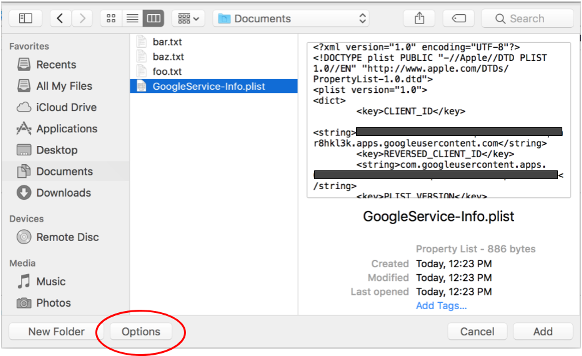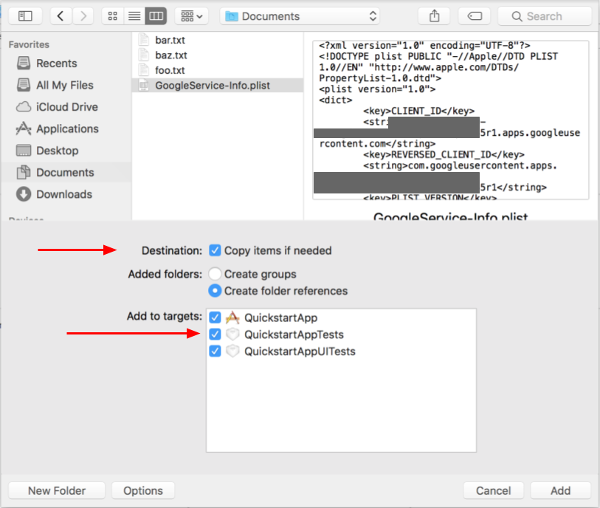The steps described on this page explain how to quickly create a simple iOS application that makes requests to the YouTube Data API. This sample shows how to retrieve data about the GoogleDevelopersYouTube channel. The code also includes comments that explain how to modify the query to retrieve data about the current user's YouTube channel.
Prerequisites
To run this quickstart, you'll need:
- Xcode 8.0 or greater.
- CocoaPods dependency manager.
- Access to the internet and a web browser.
- A Google account.
Step 1: Turn on the YouTube Data API
-
Use this wizard to create or select a project in the Google Developers Console and automatically turn on the API. Click Continue , then Go to credentials .
-
On the Create credentials page, click the Cancel button.
-
At the top of the page, select the OAuth consent screen tab. Select an Email address , enter a Product name if not already set, and click the Save button.
-
Select the Credentials tab, click the Create credentials button and select OAuth client ID .
- Select the application type iOS, enter the name "YouTube Data API
Quickstart", bundle ID
com.example.QuickstartApp, and click the Createbutton.
Step 2: Prepare the workspace
- Open Xcode and create a new project:
- Click File > New > Project, select the iOS > Application > Single View Applicationtemplate, and click Next.
- Set the Product Nameto "QuickstartApp", Organization Identifierto "com.example", and Languageto Objective-C.
Below the organization identifer, you should see a generated Bundle Identifierthat matches the iOS Bundle ID(
com.example.QuickstartApp) that you entered in step 1.b . - Click Next.
- Select a destination directory for the project and click Create.
- Close the project by clicking File > Close Project.
- Open a Terminal window and navigate to the directory that contains the
QuickstartApp.xcodeprojfile you just created. -
Run the following commands to create the Podfile, install the library, and open the resulting XCode project:
cat << EOF > Podfile && platform :ios, '8.0' target 'QuickstartApp' do pod 'GoogleAPIClientForREST/YouTube', '~> 1.2.1' pod 'Google/SignIn', '~> 3.0.3' end EOF pod install && open QuickstartApp.xcworkspace -
In the XCode Project Navigator select the project node "QuickstartApp". Then click the menu item File > Add files to "QuickstartApp".

-
Locate the
GoogleService-Info.plistfile downloaded earlier and select it. Click the Optionsbutton.
-
Make the following selections in the options window and then click the Addbutton:
- Check the Copy items if neededcheckbox.
- Check all targets listed in the Add to targetssection.

-
With the project node still selected, select "QuickstartApp" in the TARGETSsection as shown in the two images below:
-
Click the area shown in this screenshot:

-
Then select the proper target:

-
-
Select the Infotab, and expand the URL Typessection.
-
Click the +button, and add a URL schemefor your reversed client ID. To find this value, open the
GoogleService-Info.plistconfiguration file that you selected in step 2.f. Look for the REVERSED_CLIENT_IDkey. Copy the value of that key, and paste it into the URL Schemesbox on the configuration page. Leave the other fields blank. -
Rebuild the project:
- Click Product > Clean Build Folder(while holding the optionkey).
- Click Product > Build.
Step 3: Set up the sample
Replace the contents of the following files with the code provided:#import <UIKit/UIKit.h> @import GoogleSignIn ; @interface AppDelegate : UIResponder < UIApplicationDelegate > @property ( strong , nonatomic ) UIWindow * window ; @end
#import "AppDelegate.h" @implementation AppDelegate - ( BOOL ) application: ( UIApplication * ) application didFinishLaunchingWithOptions :( NSDictionary * ) launchOptions { // Initialize Google sign-in. [ GIDSignIn sharedInstance ]. clientID = @"<YOUR_CLIENT_ID>" ; return YES ; } - ( BOOL ) application: ( UIApplication * ) application openURL :( NSURL * ) url sourceApplication :( NSString * ) sourceApplication annotation :( id ) annotation { return [[ GIDSignIn sharedInstance ] handleURL : url sourceApplication : sourceApplication annotation : annotation ]; } @end
#import <UIKit/UIKit.h> @import GoogleSignIn ; #import <GTLRYouTube.h> @interface ViewController : UIViewController < GIDSignInDelegate , GIDSignInUIDelegate > @property ( nonatomic , strong ) IBOutlet GIDSignInButton * signInButton ; @property ( nonatomic , strong ) UITextView * output ; @property ( nonatomic , strong ) GTLRYouTubeService * service ; @end
#import "ViewController.h" @implementation ViewController - ( void ) viewDidLoad { [ super viewDidLoad ]; // Configure Google Sign-in. GIDSignIn * signIn = [ GIDSignIn sharedInstance ]; signIn . delegate = self ; signIn . uiDelegate = self ; signIn . scopes = [ NSArray arrayWithObjects : kGTLRAuthScopeYouTubeReadonly , nil ]; [ signIn signInSilently ]; // Add the sign-in button. self . signInButton = [[ GIDSignInButton alloc ] init ]; [ self . view addSubview : self . signInButton ]; // Create a UITextView to display output. self . output = [[ UITextView alloc ] initWithFrame : self . view . bounds ]; self . output . editable = false ; self . output . contentInset = UIEdgeInsetsMake ( 20.0 , 0.0 , 20.0 , 0.0 ); self . output . autoresizingMask = UIViewAutoresizingFlexibleHeight | UIViewAutoresizingFlexibleWidth ; self . output . hidden = true ; [ self . view addSubview : self . output ]; // Initialize the service object. self . service = [[ GTLRYouTubeService alloc ] init ]; } - ( void ) signIn: ( GIDSignIn * ) signIn didSignInForUser :( GIDGoogleUser * ) user withError :( NSError * ) error { if ( error != nil ) { [ self showAlert : @"Authentication Error" message : error . localizedDescription ]; self . service . authorizer = nil ; } else { self . signInButton . hidden = true ; self . output . hidden = false ; self . service . authorizer = user . authentication . fetcherAuthorizer ; [ self fetchChannelResource ]; } } // Construct a query and retrieve the channel resource for the GoogleDevelopers // YouTube channel. Display the channel title, description, and view count. - ( void ) fetchChannelResource { GTLRYouTubeQuery_ChannelsList * query = [ GTLRYouTubeQuery_ChannelsList queryWithPart : @"snippet,statistics" ]; query . identifier = @"UC_x5XG1OV2P6uZZ5FSM9Ttw" ; // To retrieve data for the current user's channel, comment out the previous // line (query.identifier ...) and uncomment the next line (query.mine ...). // query.mine = true; [ self . service executeQuery : query delegate : self didFinishSelector : @selector ( displayResultWithTicket : finishedWithObject : error : )]; } // Process the response and display output - ( void ) displayResultWithTicket: ( GTLRServiceTicket * ) ticket finishedWithObject :( GTLRYouTube_ChannelListResponse * ) channels error :( NSError * ) error { if ( error == nil ) { NSMutableString * output = [[ NSMutableString alloc ] init ]; if ( channels . items . count > 0 ) { [ output appendString : @"Channel information: \n " ]; for ( GTLRYouTube_Channel * channel in channels ) { NSString * title = channel . snippet . title ; NSString * description = channel . snippet . description ; NSNumber * viewCount = channel . statistics . viewCount ; [ output appendFormat : @"Title: %@ \n Description: %@ \n ViewCount: %@ \n " , title , description , viewCount ]; } } else { [ output appendString : @"Channel not found." ]; } self . output . text = output ; } else { [ self showAlert : @"Error" message : error . localizedDescription ]; } } // Helper for showing an alert - ( void ) showAlert: ( NSString * ) title message: ( NSString * ) message { UIAlertController * alert = [ UIAlertController alertControllerWithTitle : title message : message preferredStyle : UIAlertControllerStyleAlert ]; UIAlertAction * ok = [ UIAlertAction actionWithTitle : @"OK" style : UIAlertActionStyleDefault handler : ^ ( UIAlertAction * action ) { [ alert dismissViewControllerAnimated : YES completion : nil ]; }]; [ alert addAction : ok ]; [ self presentViewController : alert animated : YES completion : nil ]; } @end
Step 4: Run the sample
Switch to the QuickstartAppscheme by clicking Product > Scheme > QuickstartAppand run the sample (Cmd+R) using the device simulator or a configured device. The first time you run the sample, it will prompt you to log in to your Google account and authorize access.
Notes
- Authorization information is stored in your Keychain, so subsequent executions will not prompt for authorization.

